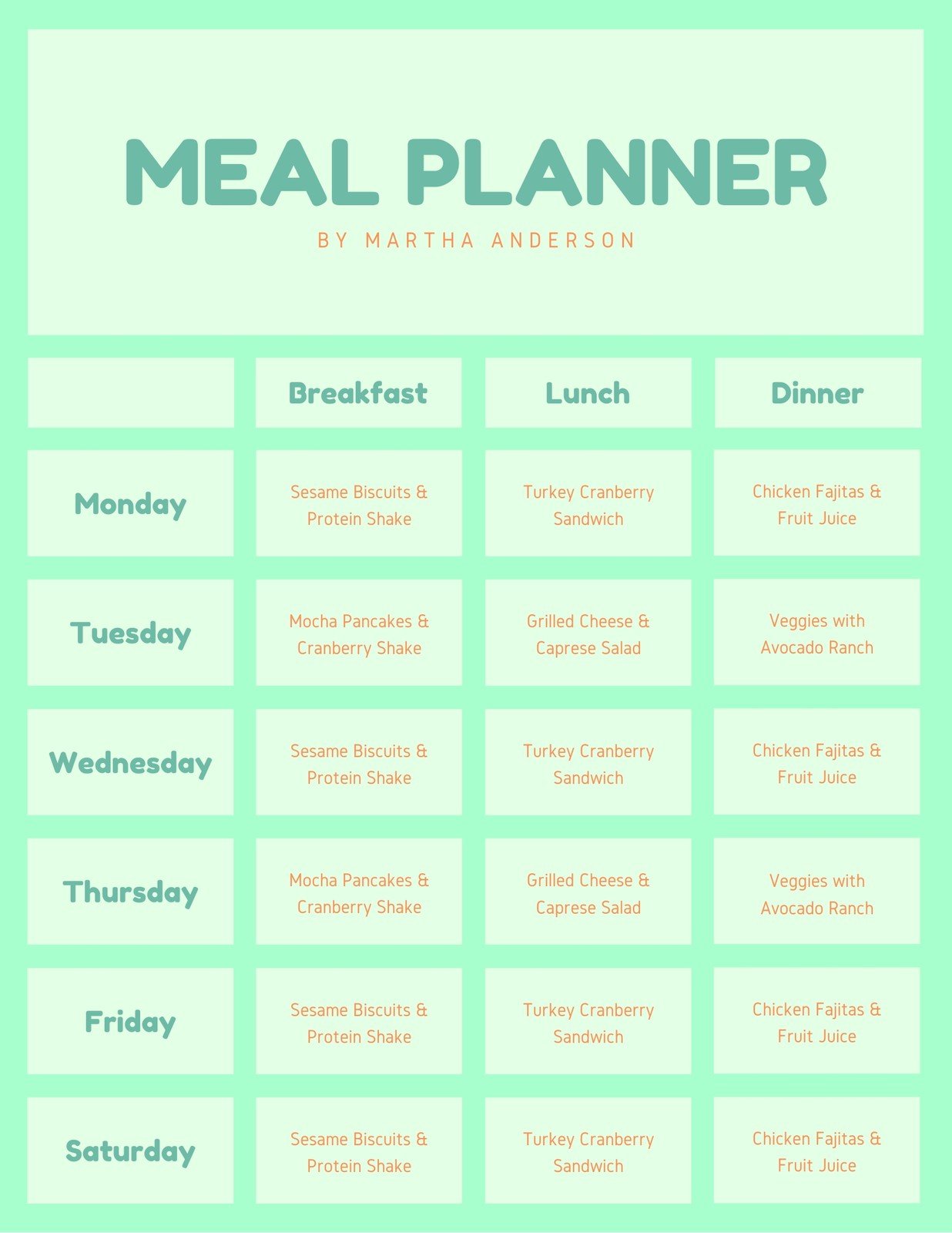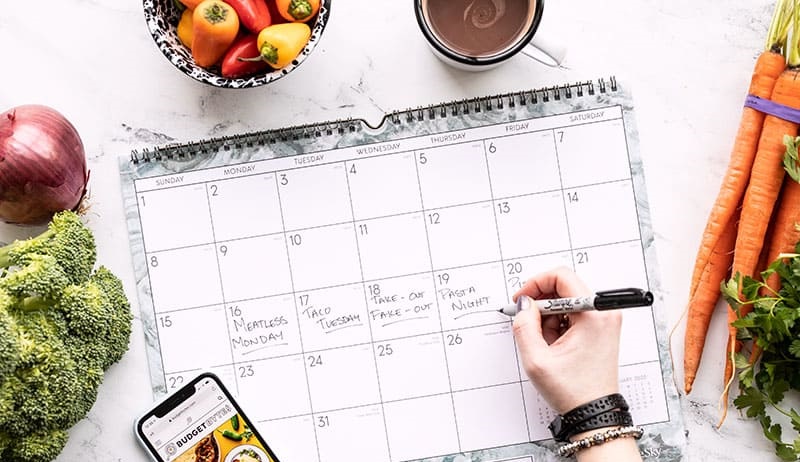To make a meal plan, list your meals for the week and include a grocery list. Focus on balanced, nutritious options.
Creating a meal plan can simplify your weekly routine and promote healthier eating habits. Start by selecting a variety of recipes that include vegetables, proteins, and whole grains. Consider your schedule and choose meals that fit your time constraints. Write down all ingredients needed and ensure you have them on hand.
Planning meals ahead reduces stress and helps avoid last-minute unhealthy choices. It also saves money by minimizing food waste and unnecessary purchases. With a little effort, meal planning can become an easy and rewarding habit that enhances your overall well-being.
Benefits Of Meal Planning
Meal planning is a powerful tool for managing your diet and lifestyle. It helps streamline your routine, improve your health, and save resources. Below, we explore the key benefits of meal planning.
Save Time And Money
Meal planning can significantly reduce grocery shopping time. When you know exactly what you need, you spend less time wandering aisles. This approach also helps avoid impulse purchases, which can be costly.
By planning meals, you can make the most of ingredients. This means fewer trips to the store and less food waste. A well-thought-out meal plan can cut your grocery bill by utilizing leftovers efficiently.
| Benefit | How it Helps |
|---|---|
| Less Shopping Time | Reduces time spent in stores |
| Fewer Impulse Buys | Saves money on unnecessary items |
| Reduced Food Waste | Uses all purchased ingredients |
Improve Nutrition
Planning meals helps ensure a balanced diet. You can easily include a variety of food groups. This approach makes it simpler to meet nutritional needs.
With a meal plan, you can control portion sizes and avoid overeating. This is crucial for maintaining a healthy weight. You can also monitor and limit unhealthy ingredients like sugar and salt.
- Balanced Diet: Ensures intake of all food groups.
- Portion Control: Prevents overeating and manages weight.
- Healthy Ingredients: Limits sugars and salts.
Incorporating a variety of fruits and vegetables becomes easier with planning. This boosts your intake of essential vitamins and minerals.

Credit: www.canva.com
Setting Your Goals
Creating a meal plan begins with setting clear goals. Knowing your goals helps you make better food choices. This section guides you in defining those goals effectively.
Identify Dietary Needs
First, identify any dietary needs. Are you allergic to certain foods? Do you follow a specific diet like vegan or gluten-free? Make a list of these needs. This ensures your meal plan is safe and suitable for you.
Here is a table to help you organize your dietary needs:
| Allergy | Diet Type |
|---|---|
| Nuts | Vegan |
| Gluten | Gluten-Free |
Define Your Objectives
Next, define your objectives. What do you want to achieve with your meal plan? Here are some common goals:
- Lose weight
- Gain muscle
- Improve energy levels
- Maintain health
Choose one or more objectives and write them down. This will guide your food choices and portion sizes.
Here is a simple list format to jot down your goals:
- Objective 1: Lose weight
- Objective 2: Improve energy levels
Setting clear goals makes meal planning easier. It keeps you focused and motivated. Start by identifying dietary needs and defining your objectives.
Choosing Recipes
Choosing recipes is the first step to a successful meal plan. It helps you decide what to cook and eat. This makes your week easy and stress-free. Here are some tips to help you choose the best recipes.
Find Healthy Options
Choose recipes with fresh vegetables, lean meats, and whole grains. These foods keep you full and give you energy. Avoid recipes with too much sugar, salt, or fat. Look for meals with lots of colors. A colorful plate often means a healthy plate.
- Use olive oil instead of butter.
- Pick whole grain bread over white bread.
- Add fruits to your breakfast meals.
Consider Variety And Balance
Eating the same food every day can get boring. Include different types of foods in your meal plan. This keeps your meals exciting and healthy. Balance your meals with protein, carbs, and fats. Here is a simple table to help you balance your meals.
| Meal Type | Protein | Carbs | Fats |
|---|---|---|---|
| Breakfast | Eggs | Oats | Avocado |
| Lunch | Grilled Chicken | Brown Rice | Olive Oil Dressing |
| Dinner | Salmon | Quinoa | Nut Butter |
Mix up your recipes every week. Try new foods and flavors. This way, you won’t get tired of your meals. Plus, you will get all the nutrients you need.

Credit: www.wikihow.com
Creating A Shopping List
Creating a shopping list is a crucial step in meal planning. It ensures you have all the necessary ingredients for your planned meals. A well-organized shopping list can save time and reduce stress. Let’s dive into some effective strategies for making a perfect shopping list.
List Essential Ingredients
Start by noting down the essential ingredients for your meals. These are the items you cannot do without. Begin with the basics like vegetables, fruits, grains, and proteins.
- Vegetables: Carrots, onions, broccoli
- Fruits: Apples, bananas, oranges
- Grains: Rice, pasta, bread
- Proteins: Chicken, beans, tofu
List any spices or condiments you need. These may include salt, pepper, and olive oil.
Organize By Store Sections
Organizing your list by store sections can make your shopping trip faster. Group items based on where they are found in the store.
| Section | Items |
|---|---|
| Produce | Carrots, apples, bananas |
| Dairy | Milk, cheese, yogurt |
| Bakery | Bread, buns, rolls |
| Meat | Chicken, beef, fish |
This method reduces the time spent wandering around the store. It helps in avoiding forgotten items.
Pro Tip: Check your pantry before listing items. This avoids buying duplicates.
Meal Prep Tips
Planning meals can save time and money. Effective meal prep ensures healthy eating. Below are some essential meal prep tips.
Batch Cooking
Batch cooking saves time during busy weeks. Prepare large portions of food. Divide them into smaller servings. This method is efficient for families.
- Cook grains like rice or quinoa in bulk.
- Prepare a large pot of soup or stew.
- Roast a variety of vegetables at once.
Batch cooking reduces daily cooking stress. It ensures a variety of meals. You can mix and match different ingredients.
Storage Solutions
Proper storage keeps food fresh longer. Use airtight containers for your meals. Label containers with dates and contents.
| Storage Type | Best Use |
|---|---|
| Airtight Containers | For cooked meals and leftovers |
| Freezer Bags | For meats and vegetables |
| Mason Jars | For salads and smoothies |
Freezing meals extends their shelf life. Use freezer-safe containers for optimal results. Always leave some space for expansion.
- Store grains and proteins separately.
- Refrigerate meals you’ll eat soon.
- Freeze meals for later weeks.
These storage solutions make meal prepping easy. They help keep your meals organized and fresh.

Credit: www.youtube.com
Incorporating Leftovers
Incorporating leftovers into your meal plan can save time and money. It also helps reduce food waste. Learn how to turn yesterday’s dinner into today’s delicious meal.
Reinvent Meals
Transforming leftovers into new dishes can be creative and fun. Here are some ideas:
- Leftover chicken: Make chicken salad or tacos.
- Cooked vegetables: Use them in a stir-fry or soup.
- Rice: Turn it into fried rice or rice pudding.
Try mixing different leftovers to create unique meals. This keeps your menu exciting and varied.
Reduce Food Waste
Using leftovers efficiently helps reduce food waste. Here’s how you can make it work:
- Label and date: Store leftovers with labels and dates. This ensures you use them in time.
- Freeze: Freeze portions of meals to use later. This extends their shelf life.
- Meal prep: Plan meals around what you have. This avoids buying unnecessary items.
Adopting these practices can make a big difference. It helps the environment and your budget.
| Leftover | New Meal Ideas |
|---|---|
| Roast Beef | Beef sandwiches, beef stew |
| Pasta | Pasta salad, pasta bake |
| Beans | Bean soup, bean dip |
Staying Flexible
Creating a meal plan is essential for organized and balanced eating. But staying flexible can make your meal plan more effective. It ensures that you can adapt to changes without stress. Below are some tips for maintaining flexibility in your meal plan.
Adjust For Changes
Sometimes, you may need to adjust your meal plan. You might find a new ingredient you want to try. Or, you may have a sudden craving. Here are some tips to help you adjust:
- Keep a list of substitute ingredients.
- Have a few quick recipes ready.
- Be open to trying new foods.
These adjustments can help keep your meal plan exciting. They also make it easier to stick to your plan.
Handle Unexpected Events
Unexpected events can disrupt your meal plan. Maybe you have to work late. Or, a friend invites you out to dinner. Here’s how you can handle these situations:
- Keep some frozen meals for emergencies.
- Plan for at least one flexible meal each week.
- Have healthy snacks on hand.
By planning for the unexpected, you can avoid stress. This makes it easier to stay on track with your meal plan.
Tracking Progress
Tracking progress helps you stay on top of your meal plan. It ensures you meet your health goals. It’s essential to monitor your journey and make necessary adjustments. Below are some ways to effectively track your progress.
Monitor Health Metrics
Regularly check your health metrics. This includes:
- Weight: Weigh yourself weekly to track changes.
- Blood Pressure: Monitor this if you have concerns.
- Blood Sugar Levels: Essential for those with diabetes.
- Cholesterol: Check this periodically.
Use a table to track these metrics:
| Metric | Current | Goal |
|---|---|---|
| Weight | 160 lbs | 150 lbs |
| Blood Pressure | 130/80 mmHg | 120/80 mmHg |
| Blood Sugar Levels | 110 mg/dL | 90 mg/dL |
| Cholesterol | 200 mg/dL | 180 mg/dL |
Reflect And Adjust
Reflect on your progress each week. Ask yourself:
- Did you meet your goals?
- What challenges did you face?
- What changes can you make?
Adjust your meal plan based on your reflections. If you’re not seeing results, consider:
- Changing portion sizes.
- Adding more fruits and vegetables.
- Reducing processed foods.
Stay flexible and patient. Progress takes time.
Frequently Asked Questions
How Do I Create My Own Meal Plan?
To create your own meal plan, set clear goals, choose balanced recipes, plan for variety, prepare a shopping list, and schedule prep time.
What Are The 5 Basic Steps Of Meal Planning?
1. Set a weekly menu based on nutritional needs and preferences. 2. Create a grocery list with necessary ingredients. 3. Shop for fresh and seasonal produce. 4. Prep ingredients in advance to save time. 5. Cook meals and store them properly for the week.
How To Create Your Own Diet Plan?
To create your own diet plan, first determine your goals. Calculate daily calorie needs. Choose nutritious foods. Balance proteins, carbs, and fats. Monitor and adjust as necessary.
How To Prepare A Meal Plan For The Week?
To prepare a weekly meal plan, list your favorite recipes, check your pantry, make a shopping list, and schedule meals. Prioritize balanced nutrition with protein, veggies, and grains.
Conclusion
Creating a meal plan can simplify your life. It saves time, reduces stress, and promotes healthy eating. Start small, stay consistent, and adjust as needed. With a bit of effort, you’ll find meal planning becomes second nature. Enjoy the benefits of a well-organized approach to your meals.
